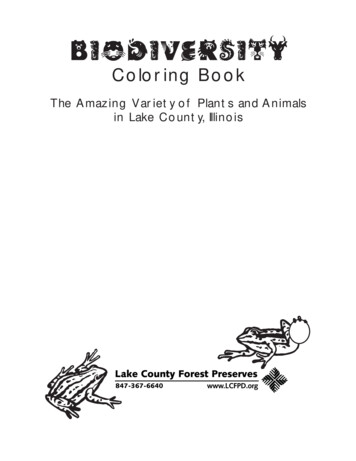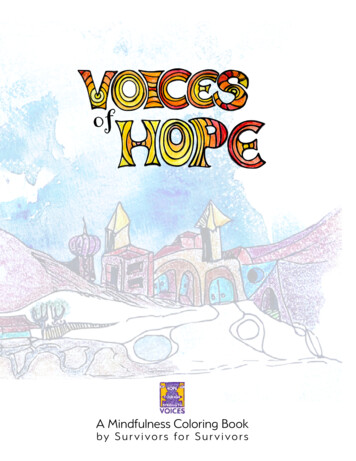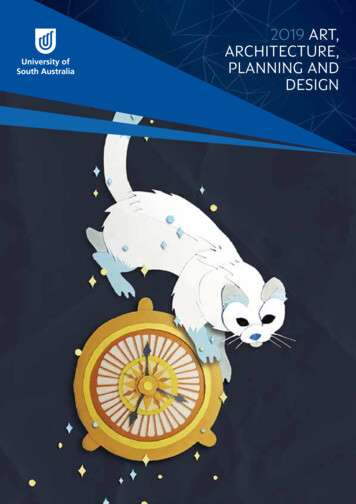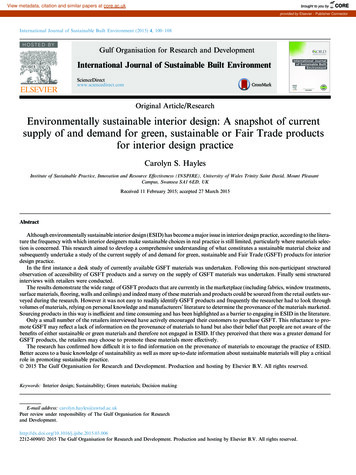
Transcription
BiodiversityColoring BookThe Amazing Variety of Plants and Animalsin Lake County, Illinois847-367-6640
Revised 5-2006 EE&PA CTS
INTRODUCTIONBiodiversity, short for “biological diversity,” refers to the variety oflife forms on Earth.Biodiversity keeps our air and water clean, regulates our climate,and provides all plants and animals (including humans) with food,shelter, clothing, medicine, and other useful products.At your Lake County Forest Preserves, we are working to preserveand restore the habitats that our native wildlife and plants need tosurvive and thrive. We are also here to help you enjoy the manywonderful creatures that live all around us.The Midwest was once covered by natural communities such asprairies, savannas, woodlands and wetlands. Human development ofthe land and non-native, invasive species have greatly affected thesecommunities. Only fragments of the original habitats have survivedto current day, jeopardizing biodiversity in Lake County.The lands surrounding Lake Michigan contain some of the greatestbiodiversity in the world. Living in the islands of habitat nestledbetween the human dwellings are thousands of native animal andplant species. Native species are those that have evolved in this regionof the country. The species in Lake County, Illinois make up some ofthe rarest natural communities on Earth.Learn more about your Forest Preserves and native plants andanimals by visiting www.LCFPD.org or by calling 847-367-6640.All illustrations in the book’s interior (except pages 27, 28, 33 & 35) werefeatured in the Lake County Forest Preserve District’s FREE monthlynewsletter, Horizons. These illustrations were created by Laura D’Argo.Original illustrations 1996-2006 Laura D’Argo847-303-5361; www.lauradargo.com
scarlet tanager (Piranga olivacea)Males of this species have a striking red body and black wings. Even though the males arebrightly colored, these birds can be difficult to see as they hunt for beetles and caterpillarshigh in the tree canopy. Scarlet tanagers can remain motionless for periods of time, hidingin the dense leaves.1
New England aster (Symphyotrichum novae-angliae)This plant can grow to be four feet tall. New England aster blooms in late summer to falland its purple flowers can last up to two months. It is commonly found in prairies, openareas in woodlands, and along rivers and lakes. The flowers are often visited by longtongued bees, bee flies, and butterflies.2
black and yellow Argiope (Argiope aurantia)This species prefers sunny areas among flowers, shrubs and tall plants. As is true in manyspider species, females of this species grow to a much larger size than males. Like otherorb-weavers, this species has three claws on each foot, one more than most spiders. Orbweavers use this third claw to help handle the threads while spinning their web.3
downy woodpecker & goldenrod gall (Picoides pubescens & Solidago spp.)This downy woodpecker is seen looking for a tasty treat in the gall of a goldenrod stem.Galls are caused when a goldenrod gall fly lays its eggs in the stem, the eggs hatch andthe larvae eat the inside of the stem. A chemical in the saliva of the larvae causes the plantto grow abnormally, creating a ball-shaped “gall” in which the larvae will live.4
wild geranium (Geranium maculatum)This plant can grow to be one and a half feet tall. Wild geranium blooms in late spring toearly summer. The petals are pale purplish pink and have fine lines running across theirsurface that act as nectar guides for its pollinators. In late summer its seed pods will popopen, curling upward and backward to fling the seeds away from the mother plant.5
American robin (Turdus migratorius)The American robin has a gray upper body and head with an orange belly. During thebreeding season, the adult males grow distinctive black feathers on their heads. This birdis commonly seen pulling up worms on lawns. Its natural home is in deep, mature forests,but it is seen in many habitats because of its tolerance to areas developed by humans.6
chorus frog (Pseudacris triseriata)This frog is the size of a penny and has three dark lines down its back. Chorus frogs areusually the first species to begin singing in early spring. Their call is a vibrating “prreeep”,which sounds like someone running their fingernail across the teeth of a comb. They canbe found in woodlands, prairies and roadside ditches.7
eastern bluebird (Sialia sialis)The eastern bluebird is found in open woodlands, savannas and fields. Adult males are brightblue on top and have an orange throat and breast. The population of this species declined duringthe early to mid-1900s due to habitat loss and nest predators. Recently, the popularity of bluebirdnest boxes across the country has led to increased populations in many areas.8
American lotus (Nelumbo lutea)The leaves of this species are circular and can grow to be as large as three feet across. Americanlotus blooms in July, producing a large, pale whitish-yellow flower. Its usual habitat is stagnantlakes and ponds with no tree cover. This plant has seeds and a large root that were used as a foodsource by Native Americans.9
fireflies (Family Lampyridae)Fireflies, also known as lightning bugs, are a type of beetle. Fireflies can be found in forestclearings and large fields. A chemical called luciferin is combined with oxygen and an enzymeto produce light in special cells of their abdomen. Males and females use these light to find eachother. Each species has a different number, length and pattern of light flashes!10
bloodroot (Sanguinaria canadensis)Bloodroot gets its name from the blood-red juice that can be extracted from the reddish-orangeroot. The juice from the root was used as a body paint and dye by Native Americans. Due to thefleshy appendages, the seeds are often distributed by ants. This is a common method of seeddistribution for woodland wildflowers, because there is less wind in wooded areas.11
bald eagle (Haliaeetus leucocephalus)The bald eagle, our national bird, is the only eagle unique to North America. At one time, theword “bald” meant “white,” not hairless. Before 1995, the bald eagle was listed as endangeredunder the Endangered Species Act in 43 of the 48 lower states. In July of 1995, the U.S. Fish andWildlife Service upgraded the status of bald eagles in the lower 48 states to “threatened.”12
red-spotted purple (Limenitis arthemis)This butterfly’s upper wings are blue and black with iridescence on the edge of the hindwing.The underside is dark brown and has three reddish-orange spots near the base of the hindwing.Adults of this species get their nectar from decaying fruit and animals, as well as tree sap. Foodsources for red-spotted purple caterpillars include black cherry, willow and cottonwood trees.13
northern cardinal (Cardinalis cardinalis)The brilliantly colored northern cardinal has the record for popularity as a state bird in theUnited States. It holds this title in seven states, including Illinois. This common bird is a winterfixture at bird feeders throughout the eastern United States. Males of this species are bright redwith a tuft on their heads, a black mask and a large orange beak.14
American bittersweet (Celastrus scandens)American bittersweet is one of the most ornamental of our hardy northern vines. This climbingwoody vine is found growing in thickets, along fence rows, and near streams. As the seed ripensin the fall, the outside of the seed capsule turns bright reddish-orange. Due to over collection ofthese fruiting branches for decorations, this species is not found as commonly as it once was.15
black-capped chickadee (Poecile atricapilla)This species is one of the most familiar birds in North America. The black-capped chickadee isa frequent visitor to bird feeders. It can be seen out flying on even the harshest winter days, abehavior which many people admire. This bird hides seeds and other food items for later use.Each item is stored in a different spot and these birds can remember thousands of hiding places.16
smooth sumac (Rhus glabra)Smooth sumac is a large shrub with thick, open-spreading limbs. It often grows in masses,forming a thicket which provides good cover for nesting birds and other wildlife. In late summerthis species forms dense clusters of dark red fruits (seen above). These fruit clusters were usedby Native Americans to make a lemonade-like drink. The leaves and roots were used for dyes.17
sandhill crane (Grus canandensis)The sandhill crane is a tall gray bird found in grasslands and wetlands. This is a very large birdwith a red forehead, white cheeks, and tufted feathers over its rump. This species feeds mostlyon grains and seeds, some insects, and small vertebrates. Sandhill cranes group together in hugenumbers during migration. More than 30,000 cranes have been counted in some areas!18
blue-spotted salamander (Ambystoma laterale)This salamander is usually found in moist woodland areas with access to fishless spring ponds.Their diet includes insects, spiders and worms. As their name suggests, this species is black withpale blue spots on the sides, limbs, belly and tail. When danger is sensed, this salamander lashesits tail back and forth and produces a noxious secretion from two glands at the base of its tail.19
Baltimore oriole (Icterus galbula)Due to its brilliant orange and black plumage, this species’ arrival is eagerly awaited by birdwatchers each spring. The Baltimore oriole prefers open areas with tall trees, which has made ita common inhabitant of parks and neighborhoods. This species weaves intricate hanging nestsusing various plant fibers, vines, string, paper and other materials.20
goldenrod (Solidago spp.)Goldenrod has the ability to crossbreed with other plants. Because of this unusual ability, thereare at least 130 different species of goldenrod in the United States alone. These plants are foundalong roadsides and in open fields with stems that grow to heights of three to seven feet. Itsyellow flowers, which generally appear in August and September, form in large clusters.21
white-breasted nuthatch (Sitta carolinensis)This is a common bird in woodlands and forested neighborhoods. The white-breasted nuthatchcan be seen hopping headfirst down the trunks of trees in search of insects for food. This speciesvisits bird feeders and will take seeds off to the side of a tree, where it wedges them into a creviceto hammer them open. This bird has a black cap, white breast and bluish-gray wings.22
bluegill (Lepomis macrochirus)This species gets its common name, bluegill, from its bright blue chin and gill covers. Mostbluegills are olive in color with bright green and brownish reflections; older fish often have apurplish hue. Their small mouth size limits the size of food they can eat. Bluegills primarily eatinsects, but larger adults have been known to consume crayfish, snails, small fish and fish eggs.23
dragonflies and damselflies (Order Odonata)There are about 6,500 living species of dragonflies and damselflies. Adults of these species areoften brightly colored and are flying predators that hunt by sight. They are usually found nearfresh water, such as ponds and rivers. A visible difference between these two insects is thatdragonflies hold their wings flat and damselflies hold them up together above their backs.24
American goldfinch (Carduelis tristis)The American goldfinch is a familiar and commonly seen bird. This species is often seen in openfields and visiting bird feeders. It uses thistles by eating the seeds and using the downy seed tuftsto line its nest. In summer the males are bright yellow with a black cap and the females are a dullolive color. This bird is one of the latest nesting birds, usually starting in late June or early July,25
eastern chipmunk (Tamias striatus)The eastern chipmunk has reddish-brown fur on its back and sides and white fur on its stomach.It has two white stripes bordered by black on its sides and one black stripe down the center of itsback. These markings mimic dead leaves on the forest floor and serve as camoflauge, protectingit from predators. This species also has cheek pouches that it uses to store and carry food.26
common yellow violet (Viola pubescens eriocarpa)Common yellow violet is a woodland wildflower that is found in nearly all areas of central andnorthern Illinois. Unlike common blue violet, this species is not seen as often in yards and otherdisturbed areas. The nectar and pollen of the flowers attract many species of bees. The seeds areeaten by various upland gamebirds, including the northern bobwhite and wild turkey.27
green frog (Rana clamitans)This frog is found near permanent bodies of water, but it prefers heavily vegetatedshorelines. Green frogs range in color from greenish-brown to yellowish-green. Theyare generally brighter in front with small irregular black spots, and males often have abright yellow throat. Tadpoles of this species grow large and usually take two summers todevelop. Listen for the green frog’s call, a banjo-like “twang” that begins in late May.28
great white trillium (Trillium grandiflorum)Great white trillium is a beautiful spring woodland wildflower whose name literally means“three parted”. This species has three petals, three sepals and three leaves. Its root wasused by Native Americans as a medicine. With age or after pollination, the flower droopsinto a slightly nodding position, and the bright white petals usually turn pink in color.29
cardinal flower (Lobelia cardinalis)Cardinal flower grows well in wet, shady habitat. The shape of the flowers allows onlyhummingbirds to access the nectar for food. Therefore, they are the only pollinators ofthis plant. The common name “cardinal” and species name “cardinalis” were chosen forthe flower’s color, reminiscent of the red robes worn by cardinals of the Catholic church.30
red fox (Vulpes vulpes)Red foxes are found in woodlands, brushlands and old fields throughout most of theUnited States. It can be difficult to spot this species, as it is shy and primarily nocturnal.They are omnivorous, eating corn, fruits, acorns, insects, birds and small mammals. Thisspecies can be identified by its reddish fur and the white tip on the end of its tail.31
eastern screech owl (Otus asio)This small “eared” owl is common in woodlands and suburban areas. Screech owls comein two different colors, a red form and a gray form. They have two calls, a descendingwhinny and a whistled trill of one pitch, neither is a screech as its name implies. The trill isused by members of a pair or a family to keep in contact with each other.32
little brown bat (Myotis lucifugus)This species is about three and a half inches long. Its fur is glossy brown on the back and agrayish-brown on the belly. These bats begin searching for food after sunset, flying ten totwenty feet above ground in search of flying insects. Their flight is guided by echolocation,a process of emitting sounds and using them to determine the distance to the object.33
dark-eyed junco (Junco hyemalis)The dark-eyed junco is commonly seen as a winter visitor at bird feeders. Its body has aplain pattern and the color can vary from gray to brown. This species can be identified byits dark hood, white outer tail feathers and white belly. There are fi fteen described races ofdark-eyed junco, and five identified subspecies.34
yellow pond lily (Nuphar lutea)Yellow pond lily, or spatterdock, is a rooted, floating-leaved plant with bright yellow flowerscommonly seen in lakes and ponds. In early spring its leaves are below the surface andlook like lettuce growing on the lake bottom. By late spring the dark green, heart-shapedleaves float on the water’s surface or stand above the water as summer progresses.35
The bald eagle, our national bird, is the only eagle unique to North America. At one time, the word “bald” meant “white,” not hairless. Before 1995, the bald eagle was listed as endangered under the Endangered Species Act in 43 o











